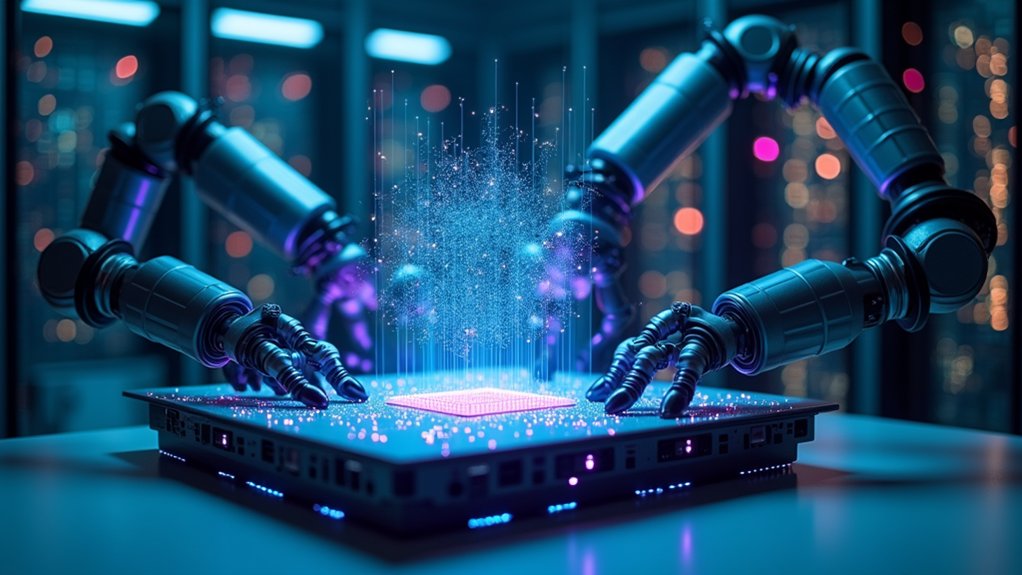Is Artificial Intelligence Really the Future of Innovation?
Artificial intelligence is certainly shaping innovation’s future, since evidenced by the global AI market‘s projected fivefold expansion within five years at a 37.3% annual growth rate. Economic impacts are substantial, with Netflix generating $1 billion annually through AI recommendations. The technology creates significant employment opportunities, with projections indicating 97 million AI-related jobs by 2025. Despite implementation challenges including ethical concerns and talent gaps, AI enhances decisional efficiency across sectors. The transformative potential of this rapidly evolving technology reveals much more about tomorrow’s innovation landscape.

How rapidly artificial intelligence has transformed from a theoretical concept to an economic juggernaut driving global innovation becomes evident when examining current market trajectories and implementation rates across industries. The global AI market, currently valued at over $600 billion, is projected to expand fivefold within the next five years, demonstrating a compound annual growth rate of 37.3% between 2022 and 2030—significantly outpacing most other technology sectors.
Enterprise adoption statistics further validate AI’s central role in modern business strategy, with 83% of companies now prioritizing AI initiatives and 89% of small businesses implementing these technologies for automation and productivity enhancements. The technology has proven its economic value, as evidenced by Netflix generating approximately $1 billion annually through its AI-driven recommendation systems, which simultaneously boost customer retention and revenue streams.
Technological advancements in AI continue to accelerate across multiple fronts. Agentic AI systems capable of autonomous problem-solving represent a significant evolution beyond conventional machine learning models. Meanwhile, specialized hardware development, including custom silicon chips designed specifically for AI workloads, is enabling faster processing capabilities necessary for sophisticated applications.
Cloud infrastructure migration intensifies as organizations seek scalable frameworks to support increasingly complex AI deployments. Hyperscalers are making substantial capital expenditures on commercial cloud servers to accommodate growing AI workloads. The workforce consequences remain substantial, with projections indicating 97 million AI-related jobs will emerge globally by 2025. In the United States, generative AI startups are attracting significant investment, with nine companies securing over $100 million each in 2025 alone.
Industries implementing AI solutions report average productivity gains of 38%, particularly in data-intensive sectors. AI is predicted to help companies in the manufacturing sector outperform their competitors by 12% in productivity. Future employment opportunities include specialized roles such as AI ethics specialists and data engineers, though persistent talent gaps remain as demand outpaces the supply of qualified professionals.
Despite promising growth trajectories, implementation challenges persist. Ethical considerations regarding algorithmic bias and potential job displacement require careful navigation. Smaller organizations often face prohibitive costs and talent acquisition difficulties.
Regulatory frameworks continue evolving to address responsible AI deployment while data quality issues impact model reliability and trustworthiness. Nevertheless, AI’s transformative potential in enhancing decisional efficiency and creating new innovation pathways remains undeniable.
Frequently Asked Questions
Can AI Replace Human Creativity Entirely?
AI cannot entirely replace human creativity due to fundamental limitations.
While AI excels at pattern recognition and generating variations based on existing data, it lacks consciousness, intention, and emotional understanding—critical components of meaningful creative work.
Humans uniquely possess non-linear thinking, cultural context comprehension, and value-driven purpose that remain beyond AI’s capabilities.
The best approach involves collaborative human-AI systems where automation handles routine tasks, allowing humans to focus on higher-order creative judgment and innovation requiring empathy and social intelligence.
How Will AI Impact Jobs Across Different Industries?
AI’s impact on jobs varies considerably across sectors.
Finance, consulting, and marketing face hiring freezes for analyst roles while technology experiences increased demand for AI specialists but reduced entry-level positions.
Manufacturing sees displacement of assembly-line workers coupled with new opportunities in automation maintenance.
Healthcare prioritizes AI-assisted diagnostics over administrative functions.
While 300 million jobs globally risk elimination, 11 million new positions in AI-intensive fields may partially offset these losses.
What Ethical Concerns Arise From Ai-Driven Innovation?
AI-driven innovation raises several ethical concerns, including bias in algorithms that perpetuate discrimination across hiring, policing, and lending decisions.
Synthetic data capabilities enable creation of deepfakes and misinformation, undermining public trust in information integrity.
Accountability challenges persist since only 25% of Americans express confidence in conversational AI systems.
Regulatory frameworks continue to lag behind technological advancements, creating governance gaps particularly in addressing deliberate data fabrication and algorithmic transparency.
Is AI Development Sustainable From an Environmental Perspective?
Current AI development practices pose significant environmental challenges.
Data centers consume 1-1.5% of global electricity with demand surging 72% from 2019-2023. Major tech companies report substantial emissions increases, with Microsoft’s growing 40% (2020-2023) and Meta’s Scope 3 emissions jumping 65% (2020-2022).
Additionally, AI operations strain water resources and generate electronic waste through rapid hardware obsolescence.
Despite sustainability initiatives emphasizing renewable energy and carbon offsets, the escalating computational demands continue to outpace environmental improvements.
How Can Small Businesses Compete in an Ai-Dominated Market?
Small businesses can compete in AI-dominated markets through strategic approaches: implementing customer-focused AI solutions like chatbots and personalized communications; leveraging affordable AI marketing tools for targeted campaigns and content optimization; automating repetitive operational tasks to improve efficiency; starting with pilot projects to measure ROI before full-scale adoption; and investing in workforce training to utilize emerging technologies effectively.
These strategies enable SMBs to harness AI capabilities without requiring enterprise-level resources.